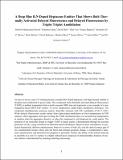A deep blue B,N-doped heptacene emitter that shows both thermally activated delayed fluorescence and delayed fluorescence by triplet-triplet annihilation
Abstract
An easy-to-access, near-UV-emitting linearly extended B,N-doped heptacene with high thermal stability is designed and synthesized in good yields. This compound exhibits thermally activated delayed fluorescence (TADF) at ambient temperature from a multiresonant (MR) state and represents a rare example of a non-triangulene-based MR-TADF emitter. At lower temperatures triplet–triplet annihilation dominates. The compound simultaneously possesses narrow, deep-blue emission with CIE coordinates of (0.17, 0.01). While delayed fluorescence results mainly from triplet–triplet annihilation at lower temperatures in THF solution, where aggregates form upon cooling, the TADF mechanism takes over around room temperature in solution when the aggregates dissolve or when the compound is well dispersed in a solid matrix. The potential of our molecular design to trigger TADF in larger acenes is demonstrated through the accurate prediction of ΔEST using correlated wave-function-based calculations. On the basis of these calculations, we predicted dramatically different optoelectronic behavior in terms of both ΔEST and the optical energy gap of two constitutional isomers where only the boron and nitrogen positions change. A comprehensive structural, optoelectronic, and theoretical investigation is presented. In addition, the ability of the achiral molecule to assemble on a Au(111) surface to a highly ordered layer composed of enantiomorphic domains of racemic entities is demonstrated by scanning tunneling microscopy.
Citation
Madayanad Suresh , S , Duda , E , Hall , D , Yao , Z , Bagnich , S , Slawin , A M Z , Bässler , H , Beljonne , D , Buck , M , Olivier , Y , Köhler , A & Zysman-Colman , E 2020 , ' A deep blue B,N-doped heptacene emitter that shows both thermally activated delayed fluorescence and delayed fluorescence by triplet-triplet annihilation ' , Journal of the American Chemical Society , vol. 142 , no. 14 , pp. 6588–6599 . https://doi.org/10.1021/jacs.9b13704
Publication
Journal of the American Chemical Society
Status
Peer reviewed
ISSN
0002-7863Type
Journal article
Description
Authors thank the Leverhulme Trust (RPG-2016-047). This project has received funding from the European Union’s Horizon 2020 research and innovation programme under the Marie Skłodowska Curie grant agreement No 838885 (NarrowbandSSL) and 812872 (TADFlife). We thank Umicore for their generous supply of catalysts. S.S. acknowledges support from the Marie Skłodowska-Curie Individual Fellowship. SB acknowledges support from the Bayrisches Staatsministerium für Wissenschaft und Kunst (Stmwk) in the framework of the initiative "SolTech", as well as from the German Science foundation (DFG) (No. 392306670). Computational resources have been provided by the Consortium des Équipements de Calcul Intensif (CÉCI), funded by the Fonds de la Recherche Scientifiques de Belgique (F.R.S.-FNRS) under Grant No. 2.5020.11, as well as the Tier-1 supercomputer of the Fédération Wallonie-Bruxelles, infrastructure funded by the Walloon Region under the grant agreement n111754.Collections
Items in the St Andrews Research Repository are protected by copyright, with all rights reserved, unless otherwise indicated.

